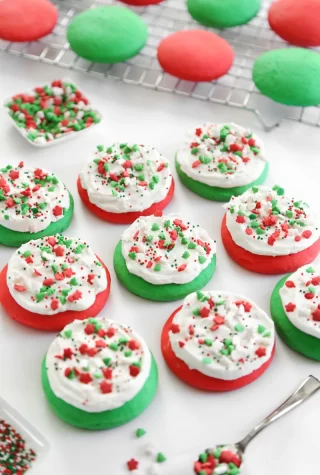Holiday Cookie Baking
There’s (finally) a smidgen of chill in the air here in San Antonio…so it’s time to bust out the candy canes, gingerbread houses, and frosted sugar cookies! Last year, I wrote about the best ways to decorate holiday cookies, but this year, I’ll describe how to make the cookies themselves.
There are two main types of cookies made for frosting: the classic, with the snappy texture and buttery flavor, and the softer, cakier versions (often called Lofthouse cookies). The former is more common. Both are usually in the style of rolled cookies, meaning that once the dough is made and usually chilled in the refrigerator for a bit, it is rolled out with a rolling pin and cut into various shapes. You will rarely see a sugar cookie of either type using brown sugar in order to keep the cookies paler and a bit drier. Both recipes also use a higher proportion of butter and sugar and less egg than drop cookies (where you “drop” balls of cookie dough onto the tray before baking, like chocolate chip cookies).
 Classic sugar cookies often have a higher proportion of flour to make the dough drier and snappier. As a result, the dough can sometimes fluctuate between being too soft and sticky when warm and hard and prone to cracking when too cold. This dough is rolled thinner and cut into more intricate shapes, so it is important to ensure that they don’t brown too much in the oven. The more intricate the shapes are, the more likely it is to bake unevenly in the oven.
Classic sugar cookies often have a higher proportion of flour to make the dough drier and snappier. As a result, the dough can sometimes fluctuate between being too soft and sticky when warm and hard and prone to cracking when too cold. This dough is rolled thinner and cut into more intricate shapes, so it is important to ensure that they don’t brown too much in the oven. The more intricate the shapes are, the more likely it is to bake unevenly in the oven.
Lofthouse cookies typically stick to thicker circles. The dough resembles cake batter in some respects to emulate the softer texture. Many recipes will add sour cream or a similar ingredient to add moisture and fat, giving it a thicker and more moist dough. Baking powder or another leavener is often added to give extra lift and make the dough airier. These two additions make the dough softer and a bit easier to work with than classic sugar cookie dough.
The more intricate your shapes are, with some areas of thinner width, the more unevenly it will bake in the oven—the thinner parts may brown more quickly. Standard shapes like circles or squares will bake more evenly, but with the right preparation, it can be avoided.
To prevent uneven baking, it is crucial that the dough stays cold. Most recipes will say to refrigerate the dough after you initially mix it for at least thirty minutes. Though it will help you when you roll out the dough, it is not as crucial as the refrigeration after you roll and cut out the dough. Particularly with intricately cut shapes and recipes using a high proportion of fat, chilling the dough after cutting will ensure that the cookies keep their shape and don’t brown too much in the oven. Though browning is often desirable in drop cookies such as chocolate chip cookies, you want to limit the browning of sugar cookies to the bottom and very edges of the cookies. Too much browning would likely make the cookies too hard and potentially taste a bit burnt—and it doesn’t look as good as a pale, even surface (after all, the main draw is the decorative frosting).
 However, sugar cookies are often criticized for being exactly that—all sugar, no other flavor. The first way to remedy this is to use quality butter and vanilla. As the primary flavors of the dough, using high-quality ingredients can add depth and richness to your cookie. Doubling the vanilla in your recipe also wouldn’t hurt—feel free to pour out vanilla extract to your heart’s content or even splurge on a vanilla bean. If you want an alternative source of flavor, you could also experiment with adding in citrus zest—orange or lemon. This wouldn’t make your cookies sour, but rather add a subtle brightness when mixed with the sugar at the beginning of the recipe. Similarly, some recipes add a small amount of almond extract to the dough. Because almond is such a powerful flavor, adding too much extract could overpower the cookie, but a little bit can add an interesting flavor. Of course, you could also flavor your frosting or icing as you please. Buttercream (mostly used for Lofthouse cookies) is easier to flavor than royal icing (better for classic sugar cookies or gingerbread), but you could experiment with either.
However, sugar cookies are often criticized for being exactly that—all sugar, no other flavor. The first way to remedy this is to use quality butter and vanilla. As the primary flavors of the dough, using high-quality ingredients can add depth and richness to your cookie. Doubling the vanilla in your recipe also wouldn’t hurt—feel free to pour out vanilla extract to your heart’s content or even splurge on a vanilla bean. If you want an alternative source of flavor, you could also experiment with adding in citrus zest—orange or lemon. This wouldn’t make your cookies sour, but rather add a subtle brightness when mixed with the sugar at the beginning of the recipe. Similarly, some recipes add a small amount of almond extract to the dough. Because almond is such a powerful flavor, adding too much extract could overpower the cookie, but a little bit can add an interesting flavor. Of course, you could also flavor your frosting or icing as you please. Buttercream (mostly used for Lofthouse cookies) is easier to flavor than royal icing (better for classic sugar cookies or gingerbread), but you could experiment with either.
Though baking is often considered to be a careful science, there’s lots of room for experimentation and customization. Sugar cookies may not be everyone’s favorite, but by finding the right flavor combination, anyone could grow to like them. Have fun baking cookies this holiday season!

Aleena is the Editor-in-Chief of the Keynote and a senior at Keystone. She enjoys reading, writing, and baking in her spare time and looks forward to discussing...

